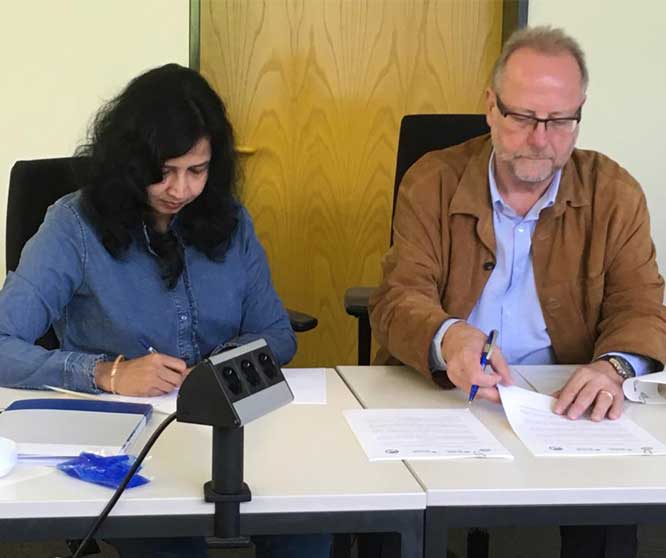

KIIT CENTRE OF EXCELLENCE
on Occupational Safety and Health
KIIT Deemed to be University in association with BG BAU, Germany; BG ETEM, Germany and Indo German Focal Point, India has established the Centre of Excellence on Occupational Safety and Health. The centre was formally inaugurated on 16th February 2019.
Vision:
To promote occupational safety and health in India and make workplace safe and healthy through Awareness, Training, and Research.
Mission:
- To create awareness among employees and employers for a safer and healthier workplace.
- To impart training to workers, employees, and employers for enhancing their skills to ensure safety at workplace
- To generate and disseminate knowledge through research activities, seminars, and conferences for ensuring a safe and healthy workplace
KIIT Deemed to be university, Bhubaneswar is one of the premier institutionsof the country with around 23 world class campuses, more than 1800 faculties, and 27000 students, spreading over 25 sq km of Academic Township. It operates with the vision to create an advanced centre of professional learning of international standing where pursuit of knowledge and excellence shall reign supreme, unfettered by the barriers of nationality, language, cultural plurality and religion. In pursuit of excellence, it is accredited with ‘A’ grade by National Accreditation and Assessment Council (NAAC), India, Category ‘A’ status from the Ministry of Human Resources Development, Govt. Of India, and ranks 42nd among Indian Universities Ranked by National Institutional Ranking Framework (NIRF), Ministry of Human Resource Development Government of India, 251-300 in QS BRICS University Rankings 2018, and 1000+ in the highly prestigious Times Higher Education Ranking, 2019.
KIIT signed a MoU with German Social Accident Insurance Institution for the building trade – BG BAU, German Social Accident Insurance Institution for the energy, textile, electrical and media products sectors – BG ETEM and Indo-German Focal Point on 8th March 2018 to establish KIIT Centre of Excellence on Occupational Safety and Health. The MoU was signed by Prof. Sasmita Samanta, Registrar, KIIT,Prof. Karl- Heinz Noetel, Director, Department for PPE and Cooperation with DGUV, of BG BAU, Dr. Jens Jühling, Prevention Manager at BG ETEM and Bimal Kanti Sahu, Director of the Indo-German Focal Point.
BG BAU and BG ETEM are German Social Accident Insurance Institutions.They promote occupational safety and health protection in the workplace, helping in preventing accidents at work and occupational diseases. After the occurrence of an accident at work or an occupational disease, they provide comprehensive care and restore the performance by any suitable means or make financial compensation.
Indo-German Focal Point for India was established in January 2017 with headquarters in Bhubaneswar, Odisha, to support projects of the German Social Accident Insurance (DGUV) on occupational safety and health in Indian enterprises, state and non-state institutions.
The purpose of the Centre of Excellence is to establish a preventive safety and health culture in the country through elimination of the incidences of work related injuries, diseases, fatalities, disasters, and to enhance the well being of all individuals working in various spheres of activities and to work on their social and emotional security.


“Every day, people die as a result of occupational accidents or work-related diseases – more than 2.78 million deaths per year. Additionally, there are some 374 million non-fatal work-related injuries and illnesses each year, many of these resulting in extended absences from work. The human cost of this daily adversity is vast and the economic burden of poor occupational safety and health practices is estimated at 3.94 percent of global Gross Domestic Product each year.”
Health is a state of complete physical, mental and social well-being and not merely the presence or absence of disease or infirmity. Occupational health and safety encompasses the social, mental and physical well-being of workers and professionals at workplace. It aims at maintenance of physical, psychological and social well-being of workers, by preventing adverse effects on workers’ health caused by their working environment, and maintaining an occupational environment adapted to physical and mental needs of workers.
Occupational safety and health is important…
Employees spend a significant part of the day in their workplace. Workplace can be termed as their Second home. Accordingly, a safe and healthy workplace plays a vital and central role in the lives of the employees. However; each and every employee may not find their workplace safe and healthy. Though, a healthy workplace is considered safe; a safe workplace may not be always healthy. Every day workers may have to face with a multitude of unhealthy factors such as dusts, gases, noise, vibration, extreme temperatures as part of their job. These workers may have to face other factors such as depression, anxiety, fatigue, harassment, mobbing, sleeplessness etc. in the workplace. Emotional and psychological circumstances of a workplace are as important condition of employment as physiological aspects of the job such as hours of work, brightness, cleanliness etc. As identified by ILO, all these unhealthy factors contribute to occupational accidents and work related diseases.
An unsafe and unhealthy workplace may cost both the employees and the employer. Work related accidents and diseases can be very costly and can have many serious direct and indirect effects on the lives of workers and their families such as health-care costs, possible loss of the job and/or income, suffering of the injury or illness, and its significant impact on the family of the employee. It may also include psychological impacts such as depression, anger, stress, isolation and loneliness, use of drugs, use of alcohol, functional limitations to day-today activities, less productivity in employment etc. These affect the workers’ family and children in terms of their own physical and mental health, their relationships among family members, social relationships, and economic circumstances.
The employer too bears several direct and indirect costs from workplace accidents and diseases such as payment for work not performed by the affected workers, medical and compensation cost, repair or replacement of damaged machinery and equipment, reduction or halt in production, re-recruitment and training expenses for replacement employees, and cost of possible reduction in the quality of work. This also creates a negative effect on the morale of other workers affecting their mental health.
Keeping aside the cost and benefit of a safe and healthy workplace for employees and employers, it is more regarding valuing the human life. The most valuable thing one can have is his/her life as it is the only one and ultimate. Each and every life is valuable, and has its own importance. Individuals work to sustain their life, and to better it. If, their life at their second home, where they spend major part of the day, is not safe and healthy, it contradicts the very purpose of being at work. Furthermore, labor has its dignity. The dignity of labor and laborers needs to be maintained at workplace. Accordingly, employees and their rights as human beings need to be protected and valued in the workplace. It will increase the satisfaction of the employees and motivate them to be productive in workplace. Sacrificing the safety and health of employees for the benefit of the rest of the society might not be an ethical practice. Above all, it is a world for all and is needed to be ensured that it remains as a world for all.
For all the reasons, it is crucial that employers and employees are committed to healthy and safe workplace. It is more crucial that both workers and employers are well informed about the health and safety risks in the workplace. It is the responsibility of both the employer and the employees to ensure a safe and healthy workplace. However, the workers are often ignorant about workplace related accidents, and diseases resulting in lack of attention and carelessness and subsequent health and safety issues. Hence workers often experience work-related health problems and do not realize that the problems have surfaced because of their workplace and/or occupational factors. Lack of information and knowledge about workplace and occupational injuries, diseases, and its signs and symptoms may result in a delay in attending the health issue. This may further deteriorate the health of the worker and may decrease the chance of recovery. Consideration of workplace injuries, illnesses, and deaths and their prevention is both timely and relevant for individual workers, their families, employing organizations, communities in which these organizations function, and the society at large.
It is essential to create awareness among workers and employees regarding the work and occupation related accidents and diseases and the responsibilities of the workers as well as the employers to maintain a safe and healthy work environment. To make the workplace safe and healthy, it requires the collaboration and participation of both employers and workers. In order to create awareness, there needs to be strong management commitment and strong worker participation in the effort. All levels of management may communicate to workers and employees, speaking with them, identifying the work procedures and equipment and facilitating others to create awareness relating to health and safety issues. This can help to save the lives of workers by creating awareness among employers and employees, reducing hazards and their consequences. Health and safety awareness programmes also have positive effects on both workers’ morale and productivity, saving employers a great deal of money. Occupational health and safety awareness programmes can be organized which may provide workers with general background information on occupational health and safety, the magnitude and variety of health and safety problems worldwide, and a hands-on knowledge to identify early symptoms of occupational diseases. Besides the awareness programmes, comprehensive training can be provided in workplace on skills development, and hazard recognition and management. It will help workers to assess their work environment, identifying potential hazards, and manage them before they become irreversible.
In this direction KIIT Centre of Excellence has conducted several awareness programmes on Occupational safety and Health for skilled workers in the state and plans to conduct many more in this direction..
The centre intends to focus more on the individuals working in unorganized sectors such as farmers, agricultural labors, forest dwellers and forest dependents across the country. In India, there are huge number of forest dwellers and dependents and more than 360 million people engaged in agriculture related activities. The workers in the the unorganized sector are one of the most ignored and ignorant population as far as their occupational safety and health is concerned. The occupational safety and health of these people need to be addressed on a priority basis so as to have a healthy society in the country.
KIIT Centre of Excellence on Occupational Safety and Health aims to emerge as one of the best in the country by 2025. It is committed to reach maximum number of people to enhance their economical, social and emotional security through various awareness programs, skill development and training programs. It also plans to offer certification courses to create a workforce who can take forward the cause further.
